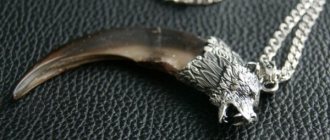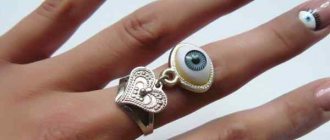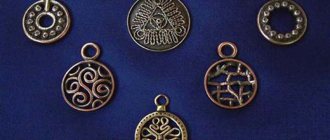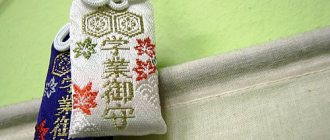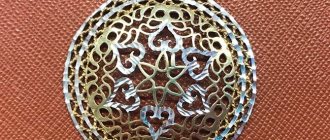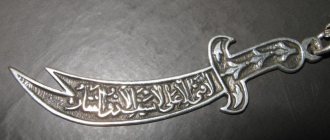Hamsa amulet - history and meaning
The word hamsa is of Hebrew origin and means the number five. But this amulet is common not only among adherents of Judaism and Islam.
From the history of the origin of the sign of the divine palm
Muslims have a whole legend associated with this amulet, which in the Islamic world is called the “hand of Fatima.” The tale tells of the daughter of the Prophet Muhammad, who was amazed to see that her husband Ali had brought a second wife into the house.
The young woman was preparing halva at that moment and, dropping her spoon in amazement, continued to stir the hot brew with her hand. The mental pain was so great that Fatima did not even think about physical pain. This is how the amulet appeared, which became a symbol of patience, dedication and faith.
The meaning of the symbol in Christianity and other religions
The shape of the hamsa resembles a palm, so in various traditions the amulet symbolizes a hand.
- Christians call the amulet “God’s right hand.” In difficult times, God extends a helping hand to the believer. It is believed that a wanderer who has a talisman with him is under the protection of the Lord himself. The sacred sign is found in paintings with spiritual themes.
- In Judaism, the talisman is called the “hand of Miriam” in honor of the sister of the biblical patriarch Moses. The amulet also symbolizes the five books of the Torah, the Holy Scripture of the Jews.
- After the Arabs were expelled from Spain, anchovy was in circulation in this country for a long time. It was only in 1526 that the Catholic Church banned the use of the Arabic talisman.
- In Ancient Phenicia, the talisman was called the “hand of Tanit” in honor of the goddess of the Moon, the spiritual protector of Carthage.
- The symbol called the "hand of Atut" was used by the ancient Egyptians, who considered it a sign of fertility.
- American Indians tattooed their bodies in the shape of a palm with an eye. According to Indian beliefs, this sign gave a person a supernatural gift to foresee future events.
- Residents of the Greek island of Cyprus perceived a similar sign as the hand of the goddess of love Aphrodite.
Meaning of the talisman hand of fatima (hamsa)
The “hand of Fatima” sign looks like an open hand with exaggerated symmetry: the thumb and little finger are depicted the same, and all other fingers are equal in size. Another name for "Khamsa" is the symbol meaning "5".
BY THE WAY! The orientation of Fatima's hand can be upward (this is often positioned in Asian countries) or downward (the most common location). Also, the sign is often supplemented with images of an eye, words of prayer, etc.
The meaning of the “hand of Fatima” talisman is different for adherents of each religion:
- the ancient Egyptians believed that the hand protected against the evil eye (they called this object the “palm of Hamesh”);
- for the Phoenicians, the open palm symbolized fertility and abundance;
- among the American Indians, this sign was a symbol of intuition (“sixth sense”), developing through the other 5 senses. The Indians made tattoos with this image to enhance intuition;
- Turkish women wear the “hand of Fatima” amulet to develop patience, fidelity and obedience to their husband;
- In general, for Muslims, 5 fingers symbolize 5 main values: fasting, prayer, pilgrimage, faith and mercy. In addition, 5 fingers are associated with the stable Arabic expression “five to the eye,” which means discharging negative energy to its source;
- Indians believe that this talisman brings good luck in business;
- Jews believe that 5 fingers reflect the Pentateuch of the Torah, as well as the number of senses with which one can comprehend God;
- among Christians, the right hand of God (the hand of God) means a sign from the Almighty and protects people on their journeys.
What unites all of the above is the interpretation of Fatima’s hand as a talisman that protects against the evil eye and negative energy and bestows good luck and prosperity.
Also, the image of an open palm is interpreted as a unification of adherents of all faiths. Thus, the symbol also has a general religious context.
What is an amulet and what qualities does it have?
Hamsa is a symbol of an open palm, but the figure has symmetry: the outer fingers are identical in shape and size. The color of the amulet is blue or light blue. It is also allowed to inlay the amulet with precious stones with a blue or azure tint.
To enhance the energy of the talisman, an additional sign is placed in the center of the palm. The choice depends on the tradition of the country. This could be a star of David, an eye, a crescent or another symbol, the meaning of which is protection from dark forces. The magic number five is also used.
The following properties are attributed to the amulet:
- protection from damage, the evil eye and other types of energy attacks;
- attracting positive energy flows, attracting good luck;
- assistance in harmonizing internal strength, neutralizing anxiety, restlessness;
- creating a blissful atmosphere around the owner of the amulet, which puts others in a friendly mood.
Permanent or temporary tattoo with the Hand of Fatima
Wearing a talisman directly on your body is a responsible decision. It is very difficult to get rid of such a symbol. Despite the absolutely positive interpretation of Hamsa, being constantly under its protection requires certain internal strength and determination.
In ancient times they believed: The amulet will protect against an arrow or blade in the back. This means that wearing an image on this part of the body will protect you from insidious death. Later, other good places for the image were identified - the neck and right wrist.
A protective tattoo or mehendi should not be flashy. It also should not be done hastily or thoughtlessly.
Shape and materials used to make the amulet
In different cultures, the “hand of Fatima” has its own specifics. The most common option is in the form of a symmetrical hand, on which an inscription is applied (for example, a fragment of a prayer). This anchovy is used as a pendant on the wall or as an image on a carpet (floor or wall). Such a talisman attracts prosperity to the house and also protects the home from natural disasters.
A hamsa in the form of a keychain can be attached to a baby stroller, and the child will be reliably protected from the evil eye, and all troubles will bypass him.
The “Hand of Fatima” can be hung in the car, and it will provide protection for the driver, passengers and the car itself. Using anchovy:
- will make the trip easy and fun;
- will prevent accidents, damage and theft of the vehicle.
Body jewelry that uses a sacred emblem is more widespread: pendants, bracelets. To protect yourself from misfortunes and attract good luck in life and love, you should ensure contact of the talisman with the body.
In the manufacture of protective amulet, different materials are used:
- Textile.
- Wood.
- Ceramics.
- Noble metals (gold, silver, platinum).
- Ordinary metals, which are then coated with blue enamel.
Hamsa can be decorated with precious and semi-precious stones and crystals. Turquoise is often used. By the way, if the amulet has a mirror surface, then it is capable of reflecting any, even the most powerful, impact. It is better to select stones for yourself, having previously familiarized yourself with their magical properties. It is also worth checking how compatible the stone is with your horoscope.
Additional strength is given to the “hand of Fatima” by the signs placed in the center of the palm. Particularly popular is the open blue eye or (as an option) the Egyptian eye of Horus. According to beliefs, anchovy with such an emblem endows the owner with universal wisdom and the protection of the light gods.
What is the Hamsa symbol made from?
A significant indicator of the versatility of the anchovy symbol is that it can be made from any materials. Wall images of the sign can be painted with ordinary paints; silver is often used in decorations. It is possible to make a symbol from ceramics.
According to beliefs, the amulet will be most powerful if it is made in blue tones, so the amulet is often decorated with turquoise or other semi-precious stones.
In the video you can see different types of amulet made from polymer clay. Filmed by Lepka channel.
How to activate the talisman
In order for the hamsa amulet to gain the necessary strength, carry out the activation procedure. Experts suggest choosing the method that you find more convenient.
Activating anchovy using the elements
In esotericism, it is customary to distinguish four elements: water, earth, fire and air. Each of them has its own energy. If the talisman receives the power of all four, it will become a reliable protector against any energy attacks.
For the activation ritual you will need:
- bowl of water;
- a small amount of salt (you can use river sand or soil);
- wax candle flame;
- To activate the air, you need to blow on the anchovy.
Before the ceremony begins, hold the amulet in your hands and feel its energy. Look closely at the amulet, address it as if you were talking to your most faithful, reliable friend. Take your time, wait for a response - the anchovy will begin to radiate warmth. Now begin the ritual, taking turns influencing the amulet with different elements. It is more logical to start from the ground - sprinkle the object with salt. Then dip the amulet in water, pass it over the candle flame and finally blow on it. At each of the four stages, say the sacred formula (the last word depends on the activation stage):
I send earth/water/fire/air at you
When all four steps have been completed, say the final phrase:
Protect me from all troubles. Repel the arrows of evil. Protect from misfortunes, protect from deceit.
Activating anchovy with a candle
Another way to fill a talisman with power requires only a burning candle and a calm environment. But during the ritual, you need to concentrate as much as possible on the magical object, try to put your whole soul into it. Light a candle and, taking anchovy in your hand, address the talisman with the words:
May sorrows not be able to cross these gates, May difficulties not come to these walls, May discord not grow in this place, May this home be full of joy, blessing and peace.
When turning to the amulet with prayer, imagine that a wave of energy is coming from the area of your heart, which fills the hamsa with protective power. Merge with the amulet, feel that you are connected to it by an invisible thread. In this case, the “hand of Fatima” will become a powerful amulet.
This symbol is everywhere
However, archaeological finds indicate that the Khamsa sign is much older than the Abrahamic religions. Similar amulets were found in Mesopotamia, where it was called the “hand of Ishtar”, “the hand of Venus”, in India, where images of Indian deities with eyes on their hands were found, and in Asia.
In the south of Russia, in the Don steppes, in the burial grounds of the Sarmatians, amulets were found in the form of the palm of the left bow with an “eye” made of blue glass inserted into it.
Ethnographer from Buryatia Surut-Khanda Syrtypova in her work “On the issue of studying the iconography of Mongolian Buddhism” writes that in 1891, Russian Emperor Nicholas II, during his visit to the Baikal region, was presented with a sculpture of the Buddhist goddess White Tara by the Khorin Buryats as a recognition of Nicholas as the incarnation of a bodhisattva. It was a forty-centimeter silver figurine depicting a seated goddess who has seven eyes, including on her feet and palms.
Obviously, the appearance of such a sign suggests that in ancient times pagans attached great importance to the human hand, recognizing it as a symbol of strength, power, domination, punishment and protection, depending on the context. It is not for nothing that miraculous properties were attributed to the hands of sorcerers, leaders or kings. The eye meant not only vision or omniscience (by analogy with the all-seeing eye of God), but also the ability to influence objects and people with a glance. Consequently, the palm and the eye depicted on it can be interpreted as the omnipotence of the one who wears it.
Tattoo with the image of a talisman
Sometimes people put protective symbols on their body in the form of a tattoo. The tradition has existed for many centuries. The sacred emblem can be applied to the following areas of the body:
- right wrist;
- the outer side of the thigh or lower leg;
- back of the neck;
- back in the area between the shoulder blades (in this case the symbol is most effective).
In order for a tattoo to serve as a talisman, and not as an ordinary design on the body, it must be applied not in a salon, but by a healer.
Women can also get the “hand of Fatima” tattoo. In this case, the symbol on the body:
- will provide protection to all family members from dark forces and evil people;
- will bring comfort and tranquility to the house;
- harmonizes relationships with her husband;
- It will help a lonely woman attract the love of a worthy person.
Women can limit themselves to a henna design, which is called mehendi. The image will not last long, it will last for a month at most, but the pattern has all the protective functions.
Both the mehendi and the tattoo must be activated as recommended above.
Who is Fatima's hand suitable for and how can it help?
Hamsa is a universal protective symbol that will not be out of place for any person. But the following will feel special benefits from wearing it:
- Children who are often sick and easily succumb to other people's influences - the amulet will mirror any negative impact on the energetic level.
- Drivers of vehicles - on the ignition key or on the rear-view mirror, an amulet will help you choose the right and easy road and avoid accidents.
- Travelers and those setting off on a long journey - the talisman will make the journey easier and help them find their way home without difficulty.
- For women, the Hand of Fatima becomes a symbol of virtue and family. A talisman that harmonizes any relationship within the family and around the wearer herself.
This amulet helps everyone who decides to wear it. It calms racing souls and impulsive thoughts. A sober outlook on life helps to find the right solution to a problem.
Hamsa is an open palm, which means both the bearer and those around them will become more honest and open to dialogue.
How to wear it correctly, where to hang the symbol
If you choose the “hand of Fatima” in the form of a pendant, you can wear the amulet on a chain (preferably made of noble metal) or on a leather cord. The talisman must be in contact with the open body.
The amulet is not worn together with other pendants: this reduces its strength.
The amulet is also worn on the wrist. For example, you can attach it to a bracelet or order a separate bracelet with an anchovy symbol printed on it. Bracelets are usually worn on the left hand to protect against the evil eye and damage. If you put the bracelet on your right wrist immediately after activation, it will help you fulfill your wish.
Like any amulet, hamsa can be applied to fabric in the form of a print or embroidery. The latter, especially made with love, has stronger energy. The design on clothes not only looks stylish, but also reflects hostile influence from the outside.
Hamsa works very effectively if the amulet is worn by both spouses or a pair of lovers. This doubles the power of the amulet, which harmonizes the relationships of partners and protects their love from envious individuals.
Also, an image with the “hand of Fatima” is placed in offices and studies. In this case the logo:
- will create an atmosphere of goodwill;
- protects you from the envy of your colleagues;
- will direct you to the line of fate leading to success;
- will help generate new ideas in business.
Differences in appearance and materials of the product
Fatima's hand can be made from any materials. But it is believed that in order to repel hostile energies, it is important that the surface of the amulet be mirror-like, that is, reflective.
Of the precious metals in the manufacture of Khamsa, gold is most often used, and silver is less often used.
Gold is an activator of energies, and silver is the opposite. Therefore, gold attracts good, and silver repels bad.
ATTENTION! If you add blue to the decoration (for example, enamel inserts or turquoise), the protective properties will be enhanced.
The inserts are traditionally made of turquoise or blue enamel.
In Muslim tradition, the color blue is considered to protect against the evil eye and evil forces. It is recommended to wear the talisman as close to the body as possible.
There are various uses for decoration:
- Khamsa ring (worn both on the lower and upper phalanges);
- Hamsa bracelet (added with elements in the form of fingers and other symbols);
- Hamsa pendant (worn both on the neck and on the arm). It is believed that such a pendant, worn on a red thread, helps, among other things, improve health;
- It is recommended to wear the pendant on a separate chain or cord.
IMPORTANT! It is not customary for adherents of the Orthodox faith to wear both an image of a cross and other symbols on their necks at the same time. Therefore, in the case of wearing a cross, they choose other methods of storing the Hamsa amulet closer to the body.
Blue eye, holy eye of Horus
In Ancient Egypt, the symbol of a palm with an eye in the center was used to decorate ritual objects (for example, sarcophagi). This eye was believed to belong to the god Horus.
The meaning of the “eye on the palm” symbol depended on the orientation of the eye: if it is the left eye, then it heals and helps to lengthen life, and if it is the right eye, it protects from evil forces.
There were 2 versions of this sign: white - for the living and black - for the deceased.
Drawing
Drawings with Hamesh are used mainly to protect a home or other premises from penetration by malicious persons.
Such images are often accompanied by written blessings and are hung either at the entrance or directly opposite it.
You may be interested in: The meaning and legends of the Slavic amulet Overcome the grass
It is believed that this protects not only from robbers, but also from fire.
Embroidery
Hand of Fatima embroidery is used in much the same way as a hand-drawn image.
It can be found on carpets, tapestry paintings, and items of clothing (to be worn closer to the body).
In addition to protecting the home, wall decoration is designed to improve the well-being of the owners of the home and contribute to the fulfillment of their desires.
There are other options for using embroidered and drawn images: they are placed inside the car to prevent accidents and theft.
Afterword
The ancient hamsa amulet is a powerful protective tool, the power of which has been tested by centuries of history. “Hand of Fatima” will reflect any negative impact and protect you from misfortune. But remember: the amulet serves only those whose souls are pure and who do not wish harm to people.
Tags: Protection, Amulets
About the author: Evgeniy Tukubaev
The right words and your faith are the key to success in the perfect ritual. I will provide you with information, but its implementation directly depends on you. But don’t worry, a little practice and you will succeed!
- Related Posts
- How to wear an amulet correctly and what is it for?
- Ladinets is the simplest and most effective way to strengthen feminine energy
- Slavic runic amulets - how to choose and activate the right talisman for protection
« Previous entry
Legend and history
According to archaeological research, the amulet was used long before the rise of Islam. Symbols similar to the Hand of Fatima can be seen on artifacts from Mesopotamia, Ancient Egypt and other ancient civilizations.
This symbol can also be seen in various cultures. In most cases, this is a strong and universal amulet. The most famous legend associated with Hamsa can be found in Muslim traditions, where it is called the Hand of Fatima .
Fatima is the youngest daughter of the Prophet Muhammad. One evening, Fatima’s husband, Ali, came home and announced the decision: it was time to bring a second wife into the family. At this time, Fatima was preparing halva on the fire. At the news, she dropped the spoon she was using to stir the boiling delicacy, but didn’t even notice it and continued stirring with her hand. Ali saw this act, realized the power of his wife’s love and abandoned the idea of a second marriage. Therefore, Fatima's hand represents faith, humility and fortitude.
The meaning of the amulet in different religions
The protective symbol occupies an important place in most world religions. In each of them it has its own meaning.
Christianity
In Christianity, including Orthodoxy, the open hand represents the hand of the Mother of God, which descends from heaven and shows a person the right path. Previously, travelers carried this symbol with them so as not to get lost on the road and quickly reach their destination.
In the Christian religion, the Hand of God can be seen on the icons of various saints. Here she symbolizes God, who protects the righteous and punishes sinners in his fair judgment.
Islam
In countries professing Islam, there is a widespread legend about the youngest daughter of the Prophet Muhammad, Fatima. The father gave the girl in marriage to his comrade-in-arms, Caliph Ali.
One day the caliph decided to marry again and brought his new wife home. At this time, Fatima was stirring the boiling halva with a ladle. When she heard the news about her lover's marriage, she was so upset that she dropped the ladle and began stirring the food with her palm, without feeling the pain of the burn.
The Caliph, seeing Fatima in a depressed state, was afraid. He realized how strong her feelings were for him and immediately divorced his new wife. He never looked at other women again and remained faithful to the daughter of the great prophet until the end of his life.
Since that time, Fatima's palm has become a sacred symbol for Muslims, meaning forgiving love, loyalty and patience.
The sacred symbol of blue is the most powerful.
Judaism
Among the Jews, the amulet is associated with Miriam, the sister of the prophet Moses. The woman had the gift of clairvoyance and enjoyed the love of her compatriots.
In the Jewish legend of the 40-year wandering in the desert, there is a mention of a well that never ran out of water. The Almighty gave it to travelers for Miriam’s sincere faith.
Thanks to this, the Jews honor Moses' sister as the savior of the people of Israel, and the sign depicting her hand is considered a symbol of peace, hope and harmony.
Other beliefs
The amulet has also become widespread in Buddhism, where it is called Abhaya Mudra. The prototype for its creation was the palm of Buddha. The figurine in the form of the right hand of the founder of Buddhism symbolizes the fearlessness given to man by higher powers.
Magic hand tattoos were popular among American Indians. They are made to develop the senses of smell, taste, vision, touch and hearing - the senses necessary to enhance intuition.
Who is the Hamsa amulet suitable for?
The Hamsa amulet can be worn by anyone, regardless of religion, age and gender. As a rule, people turn to his help:
- people who lack the confidence to take control of their lives, make difficult decisions, and act decisively in any situation;
- women who want to get married successfully or strengthen their relationship with their beloved;
- children whose energy is especially weak at an early age need protection from the unkind views of strangers.
It is important to carry the Hamsa amulet with you.
The amulet in the shape of Fatima's hand is in most cases used for individual wear. It can also be used to protect a home or car, but other amulets are better suited for these purposes.
Correctly wearing an amulet with the sign of Hamsa implies almost constant use. It cannot be removed for a long time, but must be worn closer to the body.
It is worth paying attention: Orthodox Christians are prohibited from wearing other amulets along with a cross. Therefore, Christian believers are not recommended to wear two signs on themselves at the same time, especially on the same chain.
Some believe that the Hand of Fatima amulet should only be worn with the fingers pointing down. Otherwise, the sign will play the role of a simple decoration.
Is it possible for Orthodox Christians to wear a talisman?
The attitude of the Orthodox Church towards amulets is categorical. In Christianity, it is forbidden to wear amulets of other religions or jewelry together with a pectoral cross.
The meaning of Fatima's decoration was formed in the Muslim religion. The clergy claim that there is no reason to adopt the hand figurine amulet into the Orthodox Church.
There is an opinion that Orthodox and Muslim cultures have similar talismans. In the Jewish tradition, this is a hamsa amulet, depicted in the shape of a palm. In Orthodoxy there is a talisman that has similar outlines - the Hand of God.
Fatima's hand pendant is a common attribute among Arab women and girls. It originates in Jerusalem. The talisman has a sacred meaning.
People who wear this jewelry express faith not in the only God, but in his helpers. In Israel and Tunisia these are amulets, chains, rings, pendants with magical powers. This contradicts all the canons of Orthodoxy. Priests condemn the desire of Christians to use the Fatima talisman, which calls into question faith in Jesus. This explains why religious people are afraid to wear jewelry.
You can consult with a spiritual mentor about using the amulet and receive his blessing. It is important to determine what meaning the symbol of Fatima’s power has for a particular person: whether he believes in the magical power of the hand or wears it as a decoration, a trinket, or a gift.
Religion and faith are two different concepts that everyone understands differently. The official church does not approve of mascots. A figurine of a hand cannot have power given by God.
You need to decide what significance the amulet plays in your life.
Hamsa and the hand of Fatima, the eye of Fatima in Orthodoxy
There are many symbols common in the modern world. Many people resort to their help without thinking about the meaning of a number of things. Meanwhile, some symbols can cause harm spiritually. You need to know the history of symbols in Orthodoxy and world religions in order to be sure that by wearing certain signs on our bodies we will definitely receive God’s help.
Most often, the amulet of the hand of Fatima and anchovy are purchased for protection against damage. In our article you will learn how to protect yourself from damage and what other shrines an Orthodox Christian can wear along with a pectoral cross.
